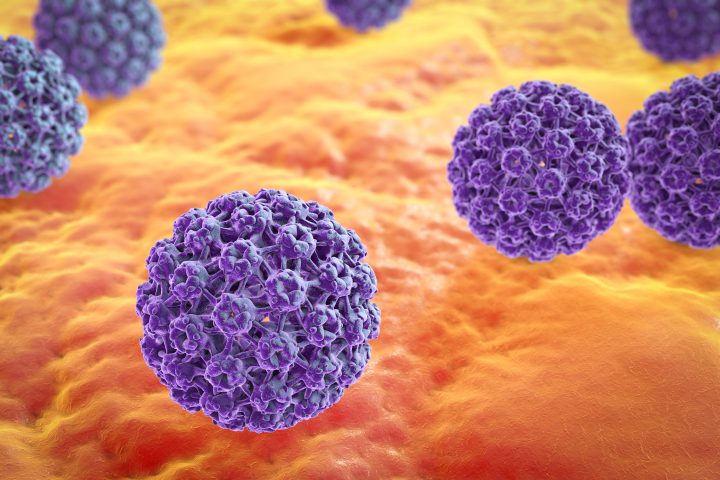In India, the second most common type of cancer among women is cervical (entry part of the womb) cancer. Cervical cancer is caused by a virus known as HPV, which also leads to cancers of the head and neck, and anogenital cancer.
 What is HPV?
What is HPV?
HPV stands for human papillomavirus, which has more than 200 different subtypes of viruses. Close to forty types of these viruses can infect the genital area including vagina, cervix, vulva, anus, penis, apart from mouth and throat. These types of HPV spread through sexual contact. Some other HPV that are not sexually transmitted cause common warts such as plantar warts or palmar warts (warts on hands or feet).
Sexually transmitted HPV of low and high-risk
Genital infections caused by HPV are very common, and most people who have unprotected sex develop HPV at some point. The body’s immune system is normally able to fight HPV naturally, after which the infected cells recover. However, in some people whose immune system is not able to fight HPV, visible changes may be seen such as single or multiple genital warts (painless growths) or cancerous changes.
While warts can appear within weeks or even months after getting the infection, and it can take years for cancer to develop.
Sexually transmitted HPV is categorized into two groups; low risk and high risk.
- Low-risk HPV typically does not cause any disease, however, some of the low risk HPV can cause warts in the throat, mouth, anus or genitals.
- High-risk HPV causes different types of cancer. While there are fourteen types of high-risk HPV, two of them, called HPV16 and HPV18 account for most of the HPV-related cancers. According to HPV Information Center’s report on Human Papillomavirus and Related Diseases, 70 percent of cervical cancer cases across the world are caused by HPV16 and HPV18. However, not all infections with HPV type 16 or 18 progress to cancer.
While genital warts are caused by low risk HPVs, high risk HPV causes cancer of vagina, cervix, anus, and vulva in women, and in men, cancer of penis and anus, and cancers of the oropharynx (the part of the throat below the mouth, that includes the palate, the base of the tongue and tonsils) in both men and women. Certain HPV strains can lead to changes in cervical cells, which if untreated can lead to cervical cancer.
Key HPV statistics in India
As per the HPV Information Center, 96,922 cases of cervical cancer are reported in India every year, with more than 60,000 deaths annually. In Indian women, 83% of cervical cancers are associated with HPV 16 & HPV 18 & with high risk cervical lesions, 62 percent of cases are due to HPV16 or HPV18.
HPV related cancers
High-risk HPVs cause cancer in areas of the body where HPV infects cells of regions including oropharynx (the region of the throat that includes the base of the tongue, soft palate and tonsils), cervix, vulva, vagina, anus, and penis.
HPV mostly affects squamous cells lining the inside part of these organs which is why most HPV-related cancers are termed as squamous cell carcinoma. Some cervical cancers are adenocarcinoma as they stem from infected cervical gland cells.
The cancers caused by HPV include:
- Cervical cancer: While it is the second leading type of cancer in Indian women, HPV is responsible for around 90% of cases of cervical cancer. 70 percent of cervical cancer cases across the world are caused by HPV16 and HPV18. Routine screening helps prevent cervical cancers since it enables oncologists to detect and remove any precancerous cells before their progression to cancer.
- Oropharyngeal cancers: While in the U.S. close to 70 percent of oropharyngeal cancers are because of HPV, and more than 17,000 new head and neck cancers are diagnosed each year in India. While a majority of these cancers are linked to alcohol and tobacco consumption, recent trends show that high-risk HPV is also a cause of oropharyngeal cancer.
- Anal cancer: Worldwide, 88 percent of anal cancers are caused by HPV. Incidence is higher in women who have a history of vulvar or cervical cancer, immunosuppressed individuals such as those infected with HIV, or those who have had organ transplantation.
- Penile cancer: HPV DNA is detected in more than 20% of penile cancer tumour cells.
- Vaginal cancer: Vaginal cancer shares a similar risk profile to cervical cancers, and it is believed that both cancers are caused by HPV infection. History of other cancers such as cancer of the cervix or ano-genital cancers is often found in women who are diagnosed with vaginal cancer.
- Vulvar cancer: A majority of vulvar cancers are due to HPV. There are two patterns of vulvar cancer with varying risk factor profiles; basaloid or warty type and keratinising type. Warty lesions associated with HPV are commonly seen in young women, while the keratinizing type, which is rarely associated with HPV, is usually seen in older women.
Preventing HPV with vaccination
In India, two vaccines that are globally licensed are available and these include a quadrivalent vaccine called Gardasil™ and a bivalent vaccine known as Cervarix™. The vaccines are available in pre-filled syringe form or in a single-dose vial for injection. The IAPCOI (Indian Academy of Pediatrics Committee on Immunisation) recommends vaccination to females as young as 9 years, as well as those in the age group of 13-26 years who haven’t completed their previous vaccination.
HPV vaccination schedule and dosing
About 80% of people are prone to an HPV infection during their lifetime. Centre for disease control and prevention (CDC) recommends 2 doses of HPV vaccine during their 11-12 years of age.
2-dose recommendation for age group 9-14 years – (0, 6-12 month schedule)
The first dose of the HPV vaccine is recommended before the 15th birthday. A minimum interval of 5 months should be given between the first and the second dose. The second dose is normally recommended between 6-12 months after receiving the first dose. In case this schedule is interrupted, the first dose may not be repeated.
3-dose recommendation for age group 15-26 years – (0, 1-2, 6 month schedule)
Three doses are recommended in people who get their first dose on or after their 15th birthday as they are likely to have some immuno-compromising conditions. In this dosage schedule, the second dose is recommended to be given within 1-2 months after the first dose, and the third dose after 6 months from the first dose.
While older women between 27 and 45 can also receive the vaccine, the benefits are less as they are likely to have been exposed to HPV already.
It is also important to note that the vaccine is only effective in preventing HPV infection while it cannot be used to treat or cure cancer or HPV infection.
Preventing HPV related cancers and diseases with personal and menstrual hygiene
Maintaining personal genital hygiene not only helps in decreasing the risk of HPV infection, but also decreases the risk of other diseases like yeast infections and bacterial vaginosis. As a product of incidence among sexually active women, here are some of the factors associated with HPV related infection:
– Use of contraceptive injections and oral pills
– Continuous use of single tampons or sanitary pads without frequently changing them
– Unhealthy sexual practices
– History of any gynaecological infections
– Pelvic inflammatory diseases and cervical inflammation
Some tips for maintaining personal and menstrual hygiene:
Change your tampons and sanitary pads frequently (4-6 hours once) – The pads are not purely cotton made and contain cellulose gels and plastic chemicals like Bisphenol A (BPA) and Bisphenol S (BPS). Phthalates, an ester used to increase the flexibility of BPS and BPA is responsible for deregulating the genes. Also, the chlorine bleaching used for the cotton may react with rayon (used as an absorbent) and produce dioxins that can cause pelvic inflammatory disease, which when not treated properly may lead to cervical cancer. Further, prolonged use of the same pads also encourages the growth of a bacteria called staphylococcus aureus that may lead to various allergies and yeast infections. Changing your pads frequently can help in avoiding such adverse effects as their reactions are usually slow.
Keep your vaginal area clean – There are chances that the microbodies tend to remain after you remove your sanitary pads, or when you use unclean hands to wash the vaginal area. Make sure your hands are clean and when you wash, and the motion should be from your vagina to the anus and not vice versa. Doing it the other way (from the anus to the vagina) can lead to the transmission of bacteria from the anus to the vagina or urethra opening, causing infections.
Avoid vaginal hygiene products during menstrual cycles – Regular use of vaginal hygiene products may be a good idea. But during menstrual cycles, vaginas have their own natural cleaning mechanisms in most women and using such hygiene products during this time may hinder the natural cleansing process, leading to infections and growth of bacteria.
Proper disposal of sanitary napkins – It is also important to wrap your napkins properly before you throw them away to ensure the bacteria doesn’t spread. Also, it is equally important to wash your hands properly post disposal as you would have gone in contact with the stained area while wrapping.
Consult a top oncologist in your area to know more about HPV screening and vaccination.


